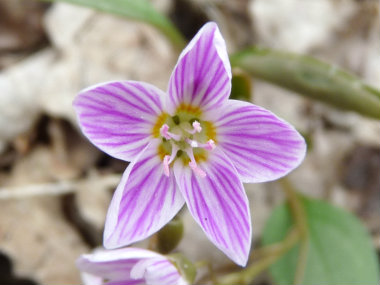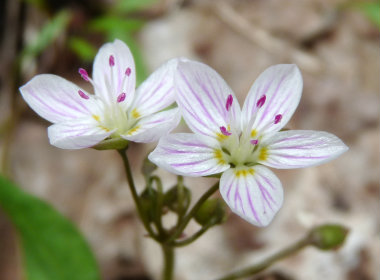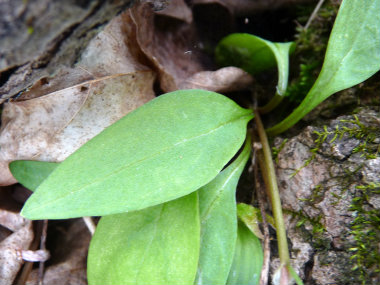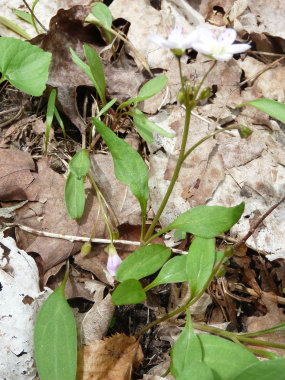







To support our efforts please browse our store (books with health benefits, etc.).
Spring beauty grows from a starchy rhizome, where it stores all the energy it made the previous season to fuel its early spring growth. The pink veins and yellow circle on the flower petals act as nectar guides for pollinators. Because those pollinators are generally out and about when the sun is shining, spring beauty only opens on sunny days. Some Native elders used this plant behavior as a barometer to predict oncoming storms.
Distinguishing Features
Spring beauty is an herbaceous perennial in the Montiaceae family. This plant is a woodland perennial that produces small flowers in spring. The petals are pink or white, with darker pink veins. The plant disappears from above the ground soon after the seed capsules have ripened. A similar plant, Claytonia virginica, has much narrower leaves.
Flowers
White and pink flowers grow in terminal clusters. Each flower has six white petals streaked with pink veins. Each flower is 2cm wide (3/4”). The very bottom of each petal is tinged with yellow so that it looks like there is a faint yellow circle in the middle of each flower.
 Fields
of Nutrition has medicinal benefits and vitamin/mineral content of Spring Beauty.
Fields
of Nutrition has medicinal benefits and vitamin/mineral content of Spring Beauty.
Leaves
One pair of leaves are on the stem. The leaf and stalk are 3 to 8 times as long as wide with the stalk obviously being distinct from the wider leaf. Each leaf is up to 8 cm long (3") and about 2cm (3/4") wide.
Height
Spring beauty can grow to 12cm (5”) tall.
Habitat
This plant can be found in rich open woods, forests, alluvial thickets and in some wetlands. They are found primarily from Ontario to the east and in eastern USA.
Edible Parts
The root can be consumed raw or cooked like potatoes. They are rich in starch; it has a pleasant nutty flavour. Leaves and stems can be eaten raw or cooked; they have a mild flavour.
Other Name
Rose Elf.
Similar Plants
Virginia Spring Beauty.
Winter Survival Food Handbook

PDF Plant Magazines
Types of Wild Food
Geographic Zones Seasons
Disclaimer
EdibleWildFood.com is informational in nature. While we strive to be 100% accurate, it is solely up to the reader to ensure proper plant identification. Some wild plants are poisonous or can have serious adverse health effects.
We are not health professionals, medical doctors, nor are we nutritionists. It is up to the reader to verify nutritional information and health benefits with qualified professionals for all edible plants listed in this web site. Please click here for more information.
Why Edible Wild Food?
- Food costs are rising
- Free, wild food is readily abundant
- Wild food adds nutrition to your diet
- Wild food can help treat various medical conditions





